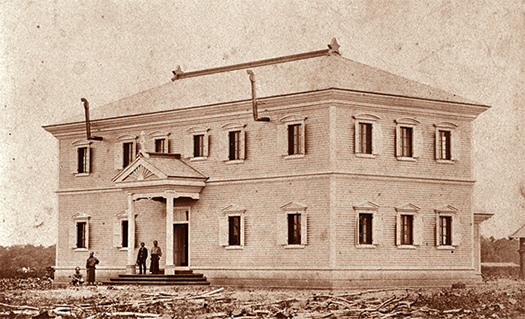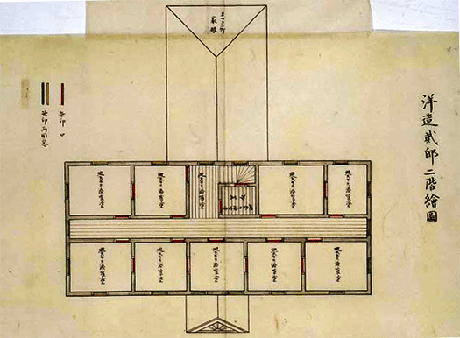
このブログでは2019-20年頃、北海道の住宅史の始原期を探って明治最初期の状況をずっと深掘りしてみていた。ちょうどコロナ禍によって社会閉塞のやむなき背景事情があったのだけれど、日常的な仕事の状況を反映したブログから、ちょっと意識変化してのブログのテーマ化だった。
いまは逆にそこで追究した素材テーマ感が自分に強く影響してきている(笑)。年齢のこともあって開拓した事業を譲渡して、いまは比較的に自由にテーマに沿った掘り起こしを志向している。
で、その過程で富岡製糸場のことに気付きが至って、北海道での始原期の開拓の実像一択でこれまで凝り固まっていたのかもと思えるようになった。わたしたち北海道人にとっては、いま現在にまでつながってくるのが、住宅性能進化に顕現した多くの先人の営為が主たる興味分野だけれど、一方で日本全体もまた、同様に「国家の近代化」に邁進してきていた事実にあまりにも無縁な姿勢だったのではないかと深く頓悟させられるのです。
上の図は富岡製糸場の「継承される革新の歴史」というすばらしいガイドブックの付録年表図の一部。不勉強だったので、まずは教科書的にその歴史を学ばせていただくのに購入して、謹んで参照させていただいています。富岡製糸場は明治5年に操業開始するのだけれど、計画は明治3年からスタートしている。同時期、北海道では以下のような「洋造」建築がどんどんと建設されていた。


同時並行した北海道・明治6年には開拓使の建築がもっとも活況を呈した1年。
象徴的建築としての「開拓使本庁舎」の大工事が進捗し、
さらに「お雇い外国人」たちがどんどん入地してきて、
いかにも北米的な「洋造新都市」がその骨格を表してきた時期。
明治からの遠雷。
150年のタイムスリップは、しかしまったく古さを感じない。
むしろ日本という国家社会を進化させようとする明治という時代の必死さに深く打たれる。
北海道人として、地域で展開した巨大な文明的進化がきわめて「現代的」なままに存続し発展進化し続けている状況に、自分自身も意識の上では「協働」感を持っていて、ひろく他を、日本全体を俯瞰するという心理にはなっていなかったのだと思われるのです。
いま、さまざまな資料類を学ばせていただきながら、明治最初期の人びとの「熱さ」を追体験しているとその熱気が直撃してくる。北海道の「高断熱高気密」という住宅革新も、大きな視点で見ればこの明治の人びとの熱い思いが結晶して事柄であると思えるのです。
そしてその明治の時代の人びとの心情を、すこしづつ掘っていきたい。まるで超高温の温泉源に出会ったような気分になっています(笑)。
English version⬇
Hokkaido Settlement and Parallel – Desperate Opening to Modernity – Tomioka Silk Mill – 4
An encounter experience at the ethnic level with modern civilization 150 years ago. Hokkaido people are fighting at the level of “living” survival. Here, it is a battle of reproduction and development. …
Around 2019-20, this blog has been exploring the primitive period of Hokkaido’s housing history and delving deeper into the situation at the beginning of the Meiji period. The Corona disaster had forced me to look into the background of the social blockage, and this was a bit of a conscious shift from a blog reflecting my daily work situation to the theme of my blog.
Now, on the contrary, the sense of material theme that I pursued there is having a strong influence on me (laughs). (laugh) Due to my age, I gave up the business that I had pioneered, and now I am oriented toward digging up materials in line with the theme in a relatively free manner.
In the process of doing so, I became aware of the Tomioka Silk Mill, and I began to think that I may have been fixated on only the actual image of the pioneer settlements in Hokkaido in the primitive period. For us Hokkaido people, our main area of interest is the activities of our predecessors as manifested in the evolution of housing performance, which is connected to the present, but on the other hand, we are deeply reminded that Japan as a whole may have been too unaware of the fact that it was also striving for “national modernization” in the same way.
The above figure is part of the chronological chart in the appendix of a wonderful guidebook entitled “History of Inherited Innovations” on the Tomioka Silk Mill. Since I had not studied the history of Tomioka Silk Mill, I bought it to learn its history as a textbook, and I am respectfully referring to it. Tomioka Silk Mill started its operation in 1872, but its planning started in 1872. At the same time, the following “Western-style” buildings were being constructed in Hokkaido.
The year 1876 was the most active year for Kaitakushi (Hokkaido Development Office) construction in Hokkaido.
The symbolic “Kaitakushi Honcho Sho” (main building) was under construction, and more and more “hired foreigners” arrived in Hokkaido, creating the framework of a “Western-style new city” that was truly North American in style.
A distant thunderbolt from the Meiji era.
The 150-year time slip, however, does not feel old at all.
Rather, we are deeply struck by the desperation of the Meiji era to evolve Japan as a national society.
As a Hokkaido-er, I was consciously “collaborating” with the huge civilizational evolution that had developed in the region and was continuing to develop and evolve in a very “modern” way, and it seems that I had not yet developed the mentality to look at other parts of the world or Japan as a whole from a bird’s eye view.
Now, as I study various materials and relive the “heat” of the people in the early Meiji period, I am directly affected by that heat. From a larger perspective, the housing innovation of “high thermal insulation and airtightness” in Hokkaido is also a crystallization of the passion of the people of the Meiji era.
I would like to explore the sentiments of the people of the Meiji era. I feel as if I have found the source of an ultra-hot hot spring (laughs).
Posted on 10月 7th, 2024 by 三木 奎吾
Filed under: 歴史探訪







コメントを投稿
「※誹謗中傷や、悪意のある書き込み、営利目的などのコメントを防ぐために、投稿された全てのコメントは一時的に保留されますのでご了承ください。」
You must be logged in to post a comment.